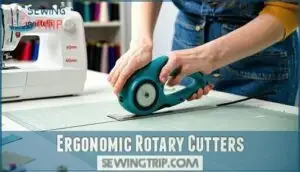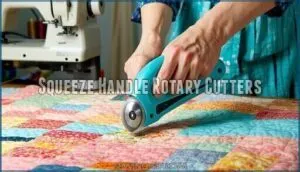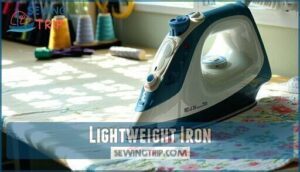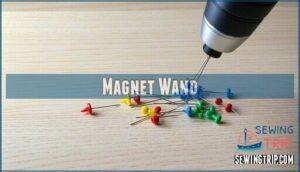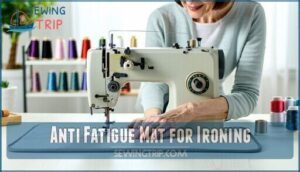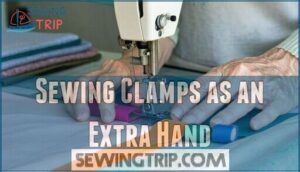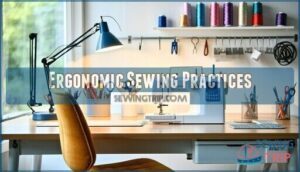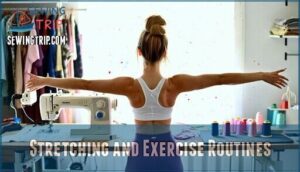This site is supported by our readers. We may earn a commission, at no cost to you, if you purchase through links.

If you’re wondering "can sewing cause arthritis," the answer is no – there’s no scientific evidence linking sewing to developing arthritis.
However, if you already have arthritis, those repetitive cutting, pinning, and stitching movements might aggravate your symptoms, think of it like this: sewing won’t break your car, but if your engine’s already struggling, a long road trip might make things worse.
The good news is that you don’t have to hang up your needles, smart ergonomic choices and proper techniques can keep you crafting comfortably for years to come, with the right approach, you can minimize the risk of exacerbating your condition and enjoy sewing without worrying about aggravating your symptoms.
Table Of Contents
Key Takeaways
- Sewing doesn’t cause arthritis, but repetitive motions can make existing joint problems worse.
- Using ergonomic tools and good sewing habits protects your joints and helps you avoid pain.
- Regular breaks and proper posture let you enjoy sewing comfortably, even if you have arthritis.
- Smart tool choices and simple tweaks in your setup go a long way in preventing hand, neck, and back pain.
Can Sewing Cause Arthritis?
You might worry that your favorite hobby could harm your joints, but sewing doesn’t directly cause arthritis.
Sewing soothes the soul, and thankfully, it won’t spark arthritis in your hardworking hands.
While repetitive hand movements can aggravate existing symptoms, the condition itself develops from factors like genetics, age, and immune system issues, not from your crafting activities.
Martelli Right Hand Rotary Cutter 60mm
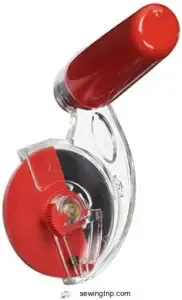
A good rotary cutter can make all the difference when you’re trying to avoid hand fatigue and repetitive strain injury from sewing.
The Martelli Right Hand Rotary Cutter 60mm stands out for its ergonomic design, which helps reduce sewing joint pain and the risk of sewing related injuries.
With a contoured handle, you’ll find your wrist stays relaxed, cutting down on the stress that can lead to hand arthritis sewing issues.
Here’s why it’s a smart pick:
- Ergonomic Design: The handle fits comfortably, easing pressure on your joints.
- Cutting Precision: Smooth, controlled cuts mean less force and fewer slips.
- Blade Replacement: Swap blades quickly—no tools needed, keeping cutter maintenance simple.
- Ambidextrous Use: Designed for right or left handers, reducing awkward angles.
There’s no proven sewing arthritis link, but smart tools like this help protect your hands, reducing the risk of repetitive strain injury and hand fatigue with smooth, controlled cuts and contoured handle design.
Rotary Cutter Fabric Cutting Tool
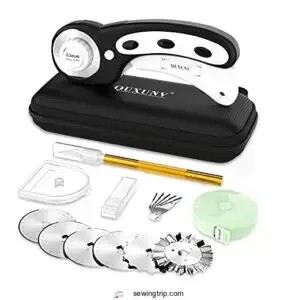
The QUXUNV Fabric Cutting Tool’s ergonomic design reduces hand arthritis sewing strain through its comfortable grip and lightweight construction.
This 45mm rotary cutter features safety features like a lock button, preventing sewing related injuries.
Its sharp blade types cut multiple fabric layers using proper cutting techniques, minimizing repetitive motions that contribute to the sewing arthritis link.
Regular maintenance tips include blade replacement for peak performance, helping prevent sewing injuries during extended crafting sessions.
Basic Clothing Iron Compact Adjustable Steam Lightweight
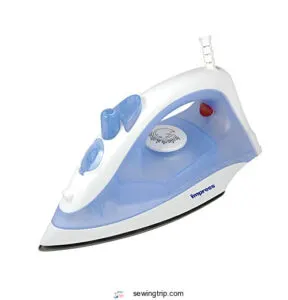
After cutting fabric, you’ll want an iron that’s easy on your hands.
The Impress Basic Clothing Iron stands out for its lightweight iron benefits—no wrist strain, even after long sewing sessions.
Iron weight matters, especially if you have arthritis or worry about sewing health risks.
Adjustable steam settings and simple iron temperature control help you avoid sewing injuries.
Plus, its compact iron storage means you won’t wrestle with bulky gear every time you tidy up.
Black and Decker Light N Easy Steam Iron
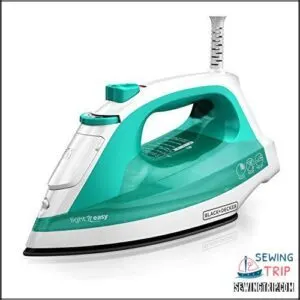
The Black+Decker Light N Easy Steam Iron delivers arthritis-friendly features that reduce sewing health risks.
Its SmartSteam Technology automatically adjusts steam output based on fabric settings, while the auto shutoff prevents overheating. The lightweight iron weight minimizes hand pain sewing, making it perfect for those concerned about arthritis risk factors.
- SmartSteam Technology – Automatically regulates steam based on fabric type, eliminating guesswork
- 8-minute auto shutoff – Safety feature prevents accidents when you’re distracted by intricate stitching
- Lightweight design – Reduces wrist strain and hand fatigue during extended pressing sessions
- Anti-drip system – Prevents water spots on delicate fabrics while maintaining consistent steam flow
Magnetic Pickup Tool LED Lights Telescoping Magnet Gadget
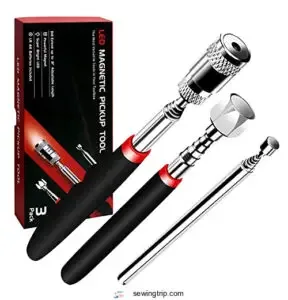
Beyond the hassle of dropped pins lies a simple solution that’ll save your joints from unnecessary strain.
The EliSmart Magnetic Pickup Tool transforms retrieval tasks into effortless motions, extending up to 32 inches so you won’t bend, crouch, or stretch uncomfortably.
This telescoping reach proves invaluable for sewing enthusiasts managing arthritis or hand pain.
Three LED illumination features spotlight hidden pins under furniture or in dim corners where your eyes might miss them.
The powerful magnet uses grab metal objects weighing up to 16 pounds, handling everything from delicate needles to heavier notions.
Material pickup becomes systematic rather than frantic searching that aggravates sore joints.
For more accurate seams, consider using a magnetic seam guide.
Ergonomic benefits include the anti-slip grip that reduces hand strain during extended sewing sessions.
Smart sewing tools like this magnetic wand help prevent the repetitive bending and reaching that can worsen existing arthritis symptoms, making your crafting time more comfortable and sustainable.
Tips and Tricks for Sewing With Arthritis and Bone Pain
If you’re living with arthritis or bone pain, you don’t have to give up your love for sewing.
Smart tool choices and proper techniques can help you continue creating while protecting your joints from unnecessary strain, which is a complete approach to managing your condition.
Ergonomic Rotary Cutters
If you’ve ever felt wrist pain after a long sewing session, it’s time to rethink your rotary cutter.
Ergonomic rotary cutters, like the Martelli 60mm, use a smart Grip Design and sharp blades to reduce strain. These arthritis prevention tips make sewing smoother and safer.
You can even find an ergonomic cutter online.
Look for:
- Comfortable Grip Design
- Sharp Blade for easy cuts
- Safety Features
- Simple Cutter Maintenance
Squeeze Handle Rotary Cutters
Squeeze handle rotary cutters offer significant ergonomic advantages for sewers dealing with hand arthritis.
You’ll find these sewing tools for arthritis reduce hand fatigue through their gentle squeezing motion, which puts less stress on joints than traditional cutters.
Here’s what makes them effective for arthritis management:
- Reduced joint strain – Squeezing motion minimizes wrist stress compared to standard rotary cutters
- Improved cutting efficiency – Continuous pressure creates smoother fabric cuts with less effort
- Comfortable grip design – Contoured handles fit naturally in your hand during extended use
- Easy blade replacement – Simple mechanisms don’t require excessive finger dexterity
- Positive user reviews – Fellow crafters consistently praise their comfort benefits
These tools transform your cutting experience from painful to pleasant, letting you focus on creativity instead of discomfort.
Many also find that using an automatic needle threader further simplifies the sewing process.
Lightweight Iron
Why struggle with a heavy iron when lighter options exist? Choosing a lightweight iron under 2 pounds reduces wrist strain and shoulder fatigue during extended pressing sessions.
Iron weight benefits include better ergonomic iron design and improved temperature control without sacrificing steam iron features. Cordless iron options offer additional freedom of movement.
For sewing with arthritis, these ergonomic tools transform your sewing machine arthritis concerns into comfortable crafting. Proper sewing ergonomics starts with smart equipment choices that support your joints throughout every project.
Many users are now purchasing lightweight sewing irons for ease of use.
Magnet Wand
In the context of pin retrieval, a magnetic wand can save your joints from unnecessary stress.
These ergonomic tools extend your reach without forcing you to crawl under your sewing machine looking for dropped pins.
- Magnetic reach extends up to 32 inches, eliminating painful bending
- Magnet strength easily grabs pins, needles, and small metal objects
- Wand length adjusts telescopically for tight spaces around your sewing area
- Ergonomic benefits reduce strain on arthritic hands and back muscles
The built-in LED lights help you spot those sneaky pins hiding in dark corners.
For sewers dealing with arthritis symptoms, this simple tool prevents the "pin hunt" that can trigger joint pain and stiffness.
Anti Fatigue Mat for Ironing
After picking up pins with a magnet wand, don’t overlook what’s under your feet.
Using an anti-fatigue mat while ironing keeps your joints happier, much like a good mattress supports your back.
Focus on Mat Material—choose one that’s durable yet soft.
Thickness Matters; a thicker mat absorbs shock better, easing arthritis pain and boosting ergonomic benefits.
Cleaning Ease is key, especially if you spill water or starch.
For storage solutions, roll the mat and tuck it away when you’re done.
Consider purchasing an anti fatigue mat for enhanced comfort.
With the right antifatigue mat, you’ll be sewing comfortably, protecting your joints, and ironing without extra aches.
Symptoms and Causes of Overuse Syndrome
If your hands ache or feel stiff after long sewing sessions, you might be experiencing overuse syndrome, which happens when you repeat the same motions for hours.
Your hands are telling you to slow down—listen before minor aches become major problems.
It’s not arthritis, but ignoring these warning signs can lead to ongoing joint pain that makes even threading a needle feel like a big task, related to joint pain.
Thumb Arthritis Surgery and Recovery
When persistent thumb pain disrupts your sewing passion, thumb arthritis surgery might offer the relief you’ve been seeking. Surgical options like ligament reconstruction and tendon interposition (LRTI) can restore function and eliminate chronic discomfort. The condition, also known as basal joint arthritis, occurs due to cartilage wear.
Recovery requires patience but delivers promising long-term outcomes:
- Post-op care involves 2-6 weeks in a splint, followed by removable bracing
- Hand therapy begins early with gentle arthritis hand exercises and strengthening
- Pain management shifts from prescription medications to targeted treatments
- Return to light sewing typically occurs within 2-4 months
Your thumb joint undergoes significant healing during the first three months. Hand exercises like stress ball squeezes help restore grip strength and dexterity. Most patients experience substantial pain relief by month three, with continued improvement lasting up to a year. With proper rehabilitation and ergonomic adjustments, you’ll likely return to pain-free sewing.
Sewing Clamps as an Extra Hand
After thumb arthritis surgery, you’ll need gentle alternatives to gripping fabric tightly.
Sewing clamps become your reliable assistant, holding material securely while your hands recover.
These ergonomic tools offer significant clamp benefits for anyone with arthritis.
They provide joint protection by eliminating the need to pinch or squeeze fabric continuously.
You can position clamps strategically around your workspace, creating multiple "third hands" that boost sewing efficiency.
When selecting sewing clamps, look for padded jaws that won’t damage delicate fabrics.
Spring-loaded versions require minimal pressure to operate, reducing strain on sensitive joints.
The ergonomic advantages are clear: less gripping means less pain and inflammation.
Consider clamps with adjustable openings for various fabric thicknesses.
Some sewers use multiple clamps simultaneously, creating an assembly line effect that keeps projects moving smoothly.
Combined with arthritis hand exercises, these tools help maintain your crafting passion without compromising joint health.
Ergonomic Sewing Practices
If you’ve ever wished you’d have a third hand like with sewing clamps, ergonomic sewing practices are your next best friend.
Paying attention to sewing posture and workstation setup can save your joints from aches and pains.
Try these tweaks:
- **Choose a supportive chair for better Seating Adjustments.
- **Keep tools within easy reach for smart Tool Placement.
- **Angle task lighting for Lighting Optimization—your eyes will thank you.
- **Set reminders for regular sewing breaks to boost Break Frequency.
Posture Awareness and sewing ergonomics make all the difference for pain-free, enjoyable projects.
Stretching and Exercise Routines
After setting up your sewing space for comfort, don’t forget to add simple flexibility exercises to your routine.
Stretch your fingers, wrists, and arms before and after sewing—think of it as a warm-up for your hands.
Try knee lifts or march in place for a quick circulation boost.
Hip circles while seated help with posture improvement and joint mobility.
Use resistance bands to strengthen wrists.
Schedule sewing breaks to prevent stiffness and support joint pain relief—arthritis prevention tips that truly work, which can aid in joint pain relief.
Can Sewing Cause Other Types of Pain and Injuries?
While arthritis isn’t directly caused by sewing, your favorite hobby can contribute to other painful conditions that might surprise you.
From hunching over your machine to repetitive hand motions, sewing can create a perfect storm for back pain, carpal tunnel, chest discomfort, eye strain, and neck pain if you’re not careful with your setup and habits, which can lead to a condition known as back pain.
Back Pain
A good sewing session shouldn’t leave you bent out of shape.
Pay attention to posture awareness—sit tall, keep your spinal alignment in check, and use a chair with lumbar support.
Strengthen your core to ease pressure on your back.
Try stretching exercises between projects.
Investing in an ergonomic chair or sewing lumbar support can make a world of difference, so your back pain doesn’t become part of your sewing routine.
Carpal Tunnel
The repetitive hand motions in sewing create nerve compression in your wrist, leading to carpal tunnel syndrome. Understanding wrist anatomy helps explain how sustained gripping and awkward positioning compress the median nerve.
Key sewing factors include prolonged cutting, pinning, and machine work without breaks. Research shows up to 68% of embroidery workers experience wrist pain, with repetitive strain being the primary culprit.
Ergonomic solutions like padded cutting mats and frequent position changes prevent symptoms. For symptom management, consider that wearing a brace may help.
When conservative treatment fails, surgical options provide lasting relief for severe cases.
Chest Pain
Moving beyond nerve compression, chest pain during sewing often stems from poor posture and prolonged positioning. When you hunch over your work, tension builds across your chest wall, creating discomfort that can feel alarming.
Non-cardiac causes like muscle strain and breathing difficulties frequently occur when sewers maintain cramped positions for hours. Anxiety and chest tightness go hand-in-hand, especially when joint pain from arthritis makes sewing more challenging. Your body tenses up, restricting natural breathing patterns and creating a cycle of discomfort.
Here’s how to prevent sewing-related chest pain:
- Maintain upright posture – Keep shoulders back and spine straight while working
- Take breathing breaks – Step away every 30 minutes for deep breaths and stretches
- Adjust your workspace – Position projects at comfortable heights to reduce hunching
- Practice chest stretches – Open your arms wide and roll shoulders backward regularly
Good ergonomics protects more than just your joints – it keeps your entire upper body comfortable and reduces inflammation throughout your sewing sessions.
Eye Strain
Poor lighting can turn your beloved sewing hobby into a recipe for eye strain faster than you can thread a needle. When you squint at tiny stitches in dim conditions, you’re forcing your eyes to work overtime, leading to fatigue, headaches, and blurred vision.
Lighting Solutions make the biggest difference. Position daylight bulbs directly over your workspace to reduce shadows and provide even illumination. Adjustable task lamps let you direct light exactly where you need it.
Magnification Options include clip-on magnifiers or lighted magnifying glasses that reduce the strain of detailed work. These tools help you see clearly without hunching forward, improving both vision and posture.
Limit Screen Time during sewing sessions, as digital devices compound eye fatigue. Take regular breaks using the 20-20-20 rule: every 20 minutes, look at something 20 feet away for 20 seconds.
Simple Eye Exercises like blinking deliberately and focusing on distant objects help reset your vision. Proper ergonomics and posture prevent you from leaning too close to your work, naturally reducing eye strain.
Neck Pain
Hunching over your sewing machine sets you up for neck pain and potential arthritis complications.
Posture awareness becomes essential when you’re absorbed in detailed work. Position your machine at elbow height and maintain an upright stance with relaxed shoulders.
Take sewing breaks every thirty minutes for neck stretches—simple head rolls work wonders. Your ergonomic setup should include proper lighting and magnification to prevent leaning forward.
To further alleviate tension, consider gentle neck rotations during these breaks. This pain management approach protects your neck while you enjoy sewing without sacrificing comfort or developing long-term issues.
Frequently Asked Questions (FAQs)
Can sewing hurt your hands?
Sarah’s grandmother developed stiff, aching hands after decades of quilting marathons without breaks.
Yes, sewing can hurt your hands through repetitive motions, poor posture, and prolonged gripping.
However, proper ergonomics, regular breaks, and supportive tools prevent most discomfort.
Can sewing cause body pain?
Yes, sewing can cause body pain if you sit too long, use poor posture, or repeat the same motions.
Take breaks, stretch, and adjust your setup—your body will thank you, and your stitches might even improve!
Why does my back hurt when I sew?
Like a broken record, sitting too long or leaning over your sewing table strains your back muscles.
Try adjusting your chair, keep your feet flat, and take breaks—your spine will thank you for the pit stop!
Can sewing cause neck pain?
Poor posture while sewing can definitely cause neck pain.
You’re likely craning your neck forward or looking down too much.
Adjust your workspace height, use proper lighting, and take regular breaks to stretch your neck muscles.
Why does my wrist hurt when I sew?
Your wrist screams for mercy because repetitive gripping, pinching, and twisting motions during sewing strain tendons and joints. Poor ergonomics, tight grips, and marathon sessions amplify this repetitive stress injury.
What if I have knee pain while sewing?
If your knees ache while sewing, try adjusting your chair height so your feet rest flat.
Take stretch breaks every hour, as sometimes, a simple shift in position or using a footrest works wonders—no need to suffer in stitches!
Is sewing bad for arthritis?
Contrary to popular belief, sewing won’t worsen your arthritis if you’re smart about it. Use ergonomic tools, take frequent breaks, and maintain proper posture to keep crafting comfortably.
Why am I suddenly getting arthritis in my hands?
You might notice arthritis in your hands as you age, thanks to genetics, old injuries, or daily wear and tear.
It’s not always fair—sometimes your joints decide to throw a curveball without warning.
Can writing too much give you arthritis?
Actions speak louder than words," but excessive writing won’t directly cause arthritis.
Like sewing, writing doesn’t trigger arthritis development.
However, repetitive hand movements can worsen existing arthritis symptoms, causing discomfort in your joints, and this is where arthritis development can become a concern.
Do musicians develop arthritis?
Musicians don’t typically develop arthritis from playing instruments.
Studies have proven that the finger movements and exercise related to playing can actually help arthritis sufferers.
However, repetitive movements may aggravate existing symptoms in affected joints.
Conclusion
Picture your hands as skilled artisans, gracefully guiding fabric through years of creative projects.
While the question "can sewing cause arthritis" concerns many crafters, remember that sewing itself doesn’t create arthritis. However, repetitive motions can aggravate existing joint conditions.
You’re not destined to abandon your passion. By choosing ergonomic tools, taking regular breaks, and practicing proper posture, you’ll protect your joints while continuing to create beautiful pieces.
Smart sewing habits guarantee your hands stay healthy and your creativity flows freely, allowing you to enjoy your craft with beautiful pieces.
- https://sewyoursoul.com/does-sewing-cause-arthritis/
- https://www.arthritis.org/health-wellness/healthy-living/daily-living/life-hacks-tips/needlework-with-hand-arthritis
- https://www.massgeneralbrigham.org/en/about/newsroom/articles/repetitive-motion-injuries
- https://pmc.ncbi.nlm.nih.gov/articles/PMC8685618/
- https://www.spiritblog.net/hand-sewing-with-hand-pain/

